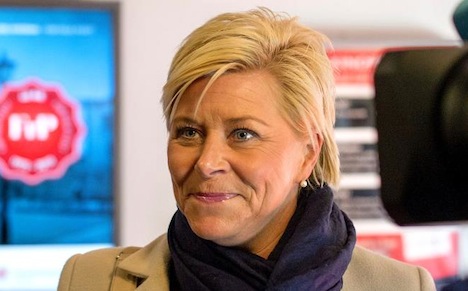Though the Høyre (‘Right,’ or Conservative Party) consistently leads polls as the party mostly likely to emerge with the most support in Norway’s September 9 elections, there’s still uncertainty about the future of Norway’s government.![]()
That’s because while Conservative leader Erna Solberg is very likely to become Norway’s next prime minister and the Conservatives are widely tipped to win on September 9, the policies that her government will pursue will depend on the relative strength of the other center-right parties — notably the populist, anti-government, anti-immigration Framskrittspartiet (Progress Party), which remains the most controversial of Norway’s major parties. If it joins the Conservatives in government as predicted, it will be the first time that the Progress Party has joined any government since it was founded in the 1970s.
If the election unfolds as polls predict, the Conservatives would win the largest share of the vote, around 32% and around 56 seats, which would be a historical victory against the Arbeiderpartiet (Labour Party), which is polling around 29% and around 51 seats. The Progress Party currently polls as the third-most popular party with around 14.5% support and around 27 seats. That means that the next government will require some kind of coalition between two of those three parties.
So while it’s not surprising that tensions are emerging during the campaign between Solberg and Progress Party leader Siv Jensen (pictured above) and that it’s clear coalition negotiations among the Conservatives, the Progress Party and other center-right allies are likely to be incredibly difficult, it is perhaps surprising that no one has really suggested a ‘grand coalition’ between Labour and the Conservatives as an alternative. While there’s no real precedent of ‘grand coalitions’ in recent Norwegian history, neither is there precedent for a Conservative-Progress government — both options would mark new ground for Norway.
Solberg is riding high in polls today after a long stint in the wilderness for the Conservatives and a rebranding exercise designed to pull the Conservatives more fully to the center and expand the party’s relevance beyond its traditional image as a party solely for Norway’s business elite. That means that it has moved more closely to Labour’s position on many issues and it’s much closer to Labour than to the Progress Party on both economic and social issues alike. Nonetheless, there’s curiously little discussion about a ‘grand coalition,’ even as Norwegians assume that the Conservative-Progress coalition is virtually a done deal. That means that the Conservatives, a party that favors continuity over rupture, will govern with the Progress Party, which has historically favored rupture over continuity. It will also likely mean that Jensen will become Norway’s next finance minister, an outcome that could scare moderate voters otherwise disposed to a Solberg-led government into supporting Labour instead.
If, for some reason, the Conservatives win the election and don’t form a coalition with Progress, because negotiations stall or because Progress’s vote collapses, the Conservatives would more likely form a coalition with two smaller center-right parties or even try a minority government before pairing up with Labour, not least of which because Labour prime minister Jens Stoltenberg has spent much of his campaign warning about all the damage that a right-wing government would cause to Norwegian society.
But on policy terms, there’s a lot to recommend a Norwegian ‘grand coalition.’ And if it can happen in Germany, Austria and Italy, why not in Norway too? Continue reading Despite doubts about far-right Progress Party, no talk of Norwegian ‘grand coalition’
